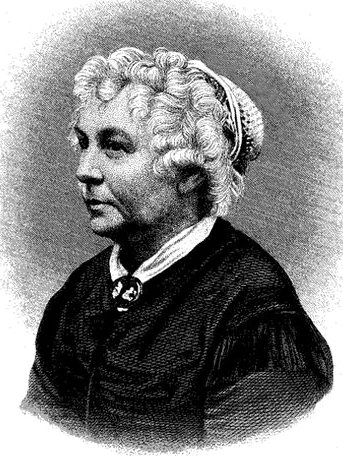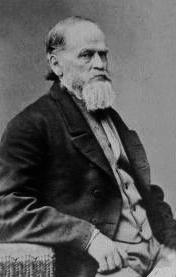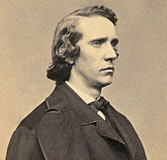
Elizabeth Cady Stanton (1815-1902)
One of the most formidable chess players ever to visit Skaneateles was Elizabeth Cady Stanton, who on at least one occasion joined her friend Susan B. Anthony at the lakeside home of Anthony’s cousin, Anson Lapham.
Elizabeth Cady was the daughter of a lawyer; she grew up being tutored in Greek, mathematics and chess by a neighbor, the Rev. Simon Hosack. When Elizabeth’s eldest sister, Tryphena, married Edward Bayard, a young lawyer, he also tutored Elizabeth in chess, along with logic and analysis, which sharpened both her debating skills and her chess game.
She later wrote, “In my younger days, chess was thought to be a necessary accomplishment. But now you seldom meet a woman who knows the game. They all say it is too hard work, as if thinking were not one of the pleasures of life.”
At the time, many young men came to study law with Elizabeth’s father, and they were at first amused by his young daughter who debated the law and the rights of women with them.
“Nothing pleased me better than a long argument with them on woman’s equality, which I tried to prove by a diligent study of the books they read and the games they played. I confess that I did not study so much for a love of the truth or my own development in those days as to make those young men recognize my equality, and I soon noticed that, after losing a few games of chess, my opponent talked less of masculine superiority.”
Her style of play, as later described by a son and daughter in an introduction to her collected letters, may have had much to do with her success:
“She played as if her very life depended upon the outcome… When she played chess, she would even-up the contest by throwing out some of her pieces at the start, she would be generous in accepting the heaviest handicap, but when the game was once started, there was never anything for her or her opponent but a fight to the finish. She neither gave nor accepted quarter. She was as intense, as uncompromising, in a game as in a suffrage contest, and defeat was as painful to her in the one situation as the other.”
In 1840, Elizabeth Cady married Henry Brewster Stanton, a prominent abolitionist; their wedding trip was a voyage to England where Henry attended an anti-slavery convention. On the return, he suffered from sea-sickness and remained in his cabin, so Elizabeth passed the time by playing chess with a British officer on his way to Canada.
In 1868, Stanton began a tour of the lecture circuit, speaking for eight months of the year as a way to finance the struggle for women’s equality. In August of that year, she joined Susan B. Anthony in Skaneateles at the home of Anson Lapham. A businessman from New York City, Lapham had retired to Skaneateles in 1861 and lived in the mansion known today as Roosevelt Hall; there he welcomed Anthony and her colleagues for respite from their travels and travails in the struggle for women’s rights.

Anson Lapham (1803-1876)
One day in Skaneateles, while looking out at the lake, Elizabeth wrote a letter to her good friend Theodore Tilton in which she anticipated their next chess game.

Theodore Tilton (1835-1907)
Tilton was a journalist who, like the Stantons, was very involved in the struggle to abolish slavery. He came to know the family, and he shared Elizabeth’s passion for chess.
When Elizabeth was editing Susan B. Anthony’s newspaper, The Revolution, she challenged Tilton to a chess “championship of the sexes.” Tilton accepted the challenge, and won the first game; Stanton won the second, and Tilton the third. Stanton said that she would leave it to Tilton to report the results, but Tilton, not one to gloat, never did.
Their most fateful game, however, was a private one, over which Tilton confided to Stanton that his wife, Julia Tilton, had confessed to having an affair with Henry Ward Beecher, one of America’s most prominent clergymen. The Tiltons had for many years attended Beecher’s church, where Julia taught Sunday School; Theodore had edited Beecher’s newspaper, The Independent, and had, in fact, helped to make Beecher famous. But when people in Beecher’s inner circle learned that Beecher had conducted an affair with Julia Tilton, they did the only thing that could be done: They fired Theodore Tilton.
After Tilton’s disclosure across the chessboard, Elizabeth Cady Stanton shared his tale of woe with her fellow women’s rights leaders Victoria Woodhull and Isabella Beecher Hooker (Henry Beecher’s sister). The Reverend Beecher had previously denounced Woodhull’s advocacy of free love; angered by his hypocrisy, Woodhull published a story in her own newspaper claiming that the clergyman was practicing in secret the free-love doctrines he had condemned from the pulpit.
Again, Beecher’s supporters did the only thing that could be done. They had Woodhull arrested and imprisoned for sending obscene material — the account of Beecher’s adultery — through the U.S. mail. Julia Tilton was successfully pressured to deny that she had ever admitted to adultery. Beecher’s church held a board of inquiry, exonerated Beecher, and excommunicated Theodore Tilton.
Theodore Tilton was now feeling rather poorly used, and sued The Reverend Beecher. Months of testimony followed, much of which centered on Theodore Tilton’s failures as a husband. Among the nuggets was a maid’s testimony that Theodore Tilton and Elizabeth Cady Stanton played chess when all the other members of the Tilton household had gone to bed. And Julia Tilton herself added this:
“He (Theodore) was absorbed in chess to such a degree that he would sometimes be up all night. I have known him to stand up at night ready for bed, engaged upon a problem in chess and to be found in that same condition in the morning without having gone to bed at all.”
The jurors were unable to reach a unanimous verdict, and Beecher’s supporters claimed he had been exonerated. Theodore Tilton had had enough of the Reverend Henry Ward Beecher, the American press, and American justice. His reputation in tatters, his marriage over, he went into self-imposed exile in Paris.
Europe was kinder to Theodore Tilton. where he often appeared in the late afternoon at the Café de la Régence to play chess. The Café drew the best players in Europe, and here Tilton was in his element. He also enjoyed the friendship of fellow expatriates, including Thomas Stanton, Elizabeth Cady Stanton’s son who was working as the European correspondent for an American newspaper, and William J. A. Fuller, who had been a good friend of Paul Morphy, perhaps the greatest chess player of the 19th century. Tilton wrote about chess for various periodicals and played every day.
In the spring of 1887, Elizabeth Cady Stanton visited her son Thomas in Paris, and was reunited with Tilton. They played “some exciting games of chess” in the apartments of William Fuller, once again sharing their passion for the game, meeting once more as equals and friends.
* * *
In 1878, Julia Tilton again confessed to having an affair with The Reverend Beecher, recanting her recantation. She was excommunicated from his church. Beecher remained in the pulpit.
In 1887, the Reverend Beecher died. It is said that Theodore Tilton was playing chess in Paris when a reporter handed him a cable that said, “BEECHER DEAD. INTERVIEW TILTON.” For a long time Tilton looked out at the street. Then he turned back to the chess board and said to the man he was playing with, “I beg your pardon… Is it my move?”
* * *
Eighty Years and More (1898) by Elizabeth Cady Stanton; Elizabeth Cady Stanton: As Revealed in Her Letters, Diary and Reminiscences (1922) edited by Theodore Stanton & Harriot Stanton Blatch; Henry Ward Beecher (1927) by Paxton Hibben; photograph of Anson Lapham by Isaac G. Tyson of Philadelphia, circa 1875, from the collection of the Friends Historical Library of Swarthmore College, a gift of Albert Cook Meyers, 1940. The Friends Historical Library was started in 1871 by Anson Lapham’s gift of 150 volumes conerning the Quakers in America.
